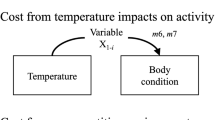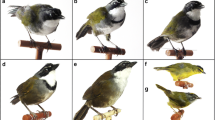Abstract
Territorial behaviour, whereby dominant animals gain priority access to critical resources, is widespread in some animal lineages, but rare in others. Theory suggests that territoriality will evolve only when animals can economically defend sites that contain critical resources (typically mates, sometimes food). In striking contrast to their close relatives the lizards, male defence of territories for access to mates has not been reported in snakes. In south-eastern Australia, receptive female small-eyed snakes thermoregulate under “hot rocks”, concentrating mating opportunities and thus, potentially allowing males to enhance their fitness by defending these rocks from rivals. We videotaped staged contests between resident and intruder males and analysed data on cohabitation patterns from a long-term (21 years) mark-recapture study. In staged contests, males actively defended hot rocks from intruder males; and thus, larger males actively displaced their smaller rivals. In the wild, larger males were found under rocks with more or larger females. These results suggest that the thermally driven concentration of female small-eyed snakes has rendered hot rocks economically defensible, and thus favoured the evolution of territoriality in a snake.

Similar content being viewed by others
References
Archer J (1988) The behavioural biology of aggression. Cambridge University Press, Cambridge
Brooks RC, Griffith SC (2010) Mate choice. In: Westneat DF, Fox CW (eds) Evolutionary behavioural ecology. Oxford University Press, Oxford, pp 416–433
Brown JL (1964) The evolution of diversity in avian territorial systems. Wilson Bull 76:160–169
Cogger HG (2000) Reptiles and amphibians of Australia. Reed New Holland, Sydney, Australia
Duvall D, Schuett GW, Arnold SJ (1993) Ecology and evolution of snake mating systems. In: Seigel RA, Collins JT (eds) Snakes: ecology and behavior. McGraw-Hill, Inc., New York, pp 165–200
Emlen ST, Oring LW (1977) Ecology, sexual selection, and the evolution of mating systems. Science 197:215–223
Fedina TY, Lewis SM (2008) An integrative view of sexual selection in Tribolium flour beetles. Biol Rev Camb Philos Soc 83:151–171
Gibbs HL, Weatherhead PJ (2001) Insights into population ecology and sexual selection in snakes through the application of DNA-based genetic markers. J Hered 92:173–179
Huang WS, Greene HW, Chang TJ, Shine R (2011) Territorial behavior in Taiwanese kukrisnakes (Oligodon formosanus). P Natl Acad Sci USA 108:7455–7459
Huey RB (1991) Physiological consequences of habitat selection. Am Nat 137:S91–S115
Kaufmann JH (1983) On the definitions and functions of dominance and territoriality. Biol Rev Camb Philos Soc 58:1–20
Keogh JS, Webb JK, Shine R (2007) Spatial genetic analysis and long-term mark-recapture data demonstrate male biased dispersal in a snake. Biol Lett 3:33–35
Kim JW, Grant JWA (2007) Effects of patch shape and group size on the effectiveness of defence by juvenile convict cichlids. Anim Behav 73:275–280
Madsen T, Shine R (1993) Male mating success and body size in European grass snakes. Copeia 1993:561–564
Pringle RM, Webb JK, Shine R (2003) Canopy structure, microclimate, and habitat selection by a nocturnal snake, Hoplocephalus bungaroides. Ecology 84:2668–2679
Pringle RM, Syfert M, Webb JK, Shine R (2009) Quantifying historical changes in habitat availability for endangered species: use of pixel- and object-based remote sensing. J Appl Ecol 46:544–553
Schuett GW, Gillingham JC (1989) Male-male agonistic behaviour of the copperhead, Agkistrodon contortrix. Amphibia-Reptilia 10:243–266
Shine R (1984) Reproductive biology and food-habits of the Australian elapid snakes of the genus Cryptophis. J Herpetol 18:33–39
Shine R (2003) Reproductive strategies in snakes. Proc R Soc Lond B 270:995–1004
Stamps J (1983) Sexual selection, sexual dimorphism, and territoriality. In: Huey RB, Pianka ER, Schoener TW (eds) Lizard ecology: studies of a model organism. Harvard University Press, Cambridge, pp 169–204
Webb JK, Whiting MJ (2005) Why don’t small snakes bask? Juvenile broad‐headed snakes trade thermal benefits for safety. Oikos 110:515–522
Webb JK, Brook BW, Shine R (2002) What makes a species vulnerable to extinction? Comparative life-history traits of two sympatric snakes. Ecol Res 17:59–67
Webb JK, Brook BW, Shine R (2003) Does foraging mode influence life history traits? A comparative study of growth, maturation and survival of two species of sympatric snakes from south-eastern Australia. Austral Ecol 28:601–610
Webb JK, Pringle RM, Shine R (2004) How do nocturnal snakes select diurnal retreat sites? Copeia 2004:919–925
Acknowledgments
We thank S. Keogh, I. Scott, W. Smith, and M. Elphick for logistical assistance and all the volunteers who assisted with fieldwork. We thank an anonymous reviewer for comments that helped to improve the manuscript.
Funding
The research was funded by the University of Sydney (Sesqui Postdoctoral Research Fellowship to JKW), the Australian Academy of Science (Margaret Middleton Award for Conservation to JKW), and the Australian Research Council (to RS).
Conflict of interests
The authors declare that they have no conflict of interest.
Author information
Authors and Affiliations
Corresponding author
Additional information
Communicated by S. J. Downes
Rights and permissions
About this article
Cite this article
Webb, J.K., Scott, M.L., Whiting, M.J. et al. Territoriality in a snake. Behav Ecol Sociobiol 69, 1657–1661 (2015). https://doi.org/10.1007/s00265-015-1977-y
Received:
Revised:
Accepted:
Published:
Issue Date:
DOI: https://doi.org/10.1007/s00265-015-1977-y




